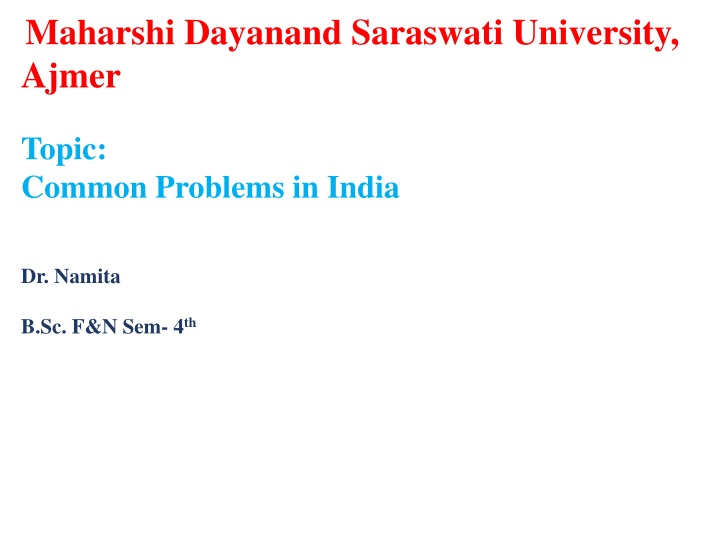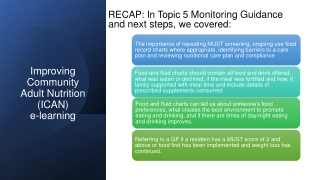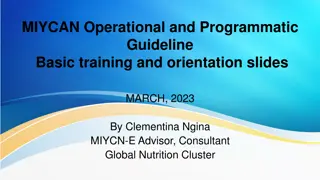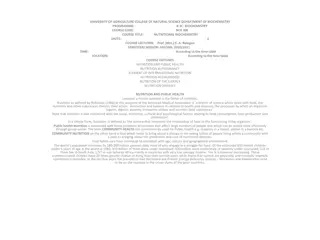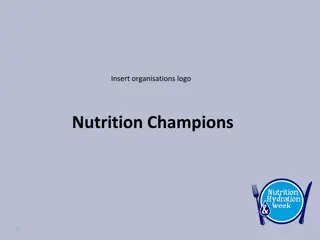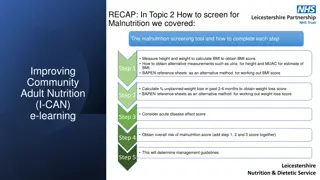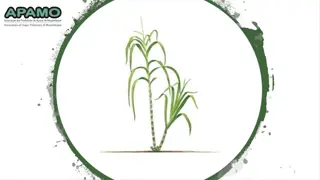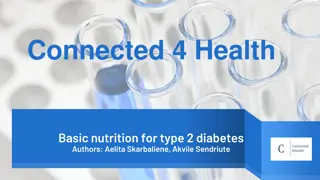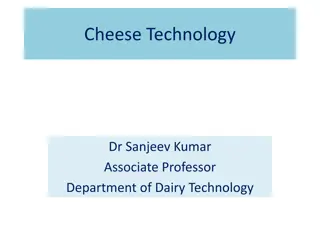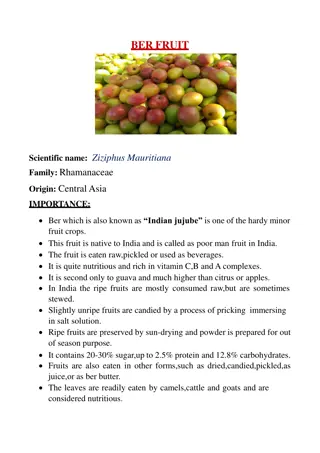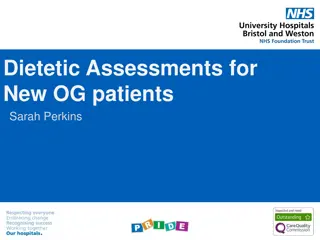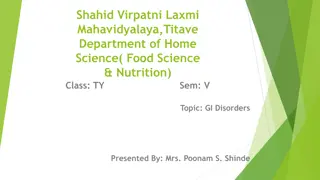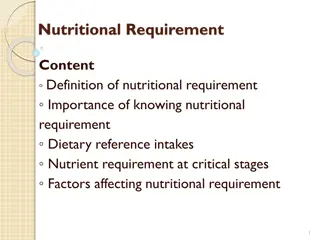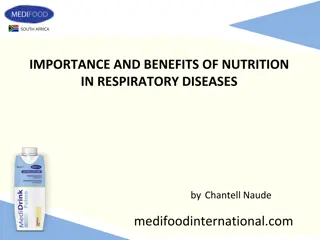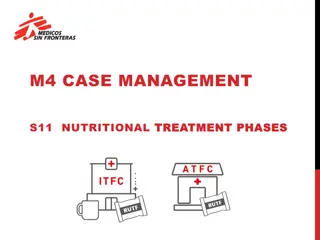Nutritional Challenges in India: A Comprehensive Overview
India faces various nutritional problems, including protein-energy malnutrition, vitamin deficiencies, and macronutrient issues. The population struggles with common ailments like anemia, heart diseases, and obesity due to micronutrient deficiencies. Understanding and addressing these challenges are crucial for improving the overall health of communities in India.
Download Presentation

Please find below an Image/Link to download the presentation.
The content on the website is provided AS IS for your information and personal use only. It may not be sold, licensed, or shared on other websites without obtaining consent from the author.If you encounter any issues during the download, it is possible that the publisher has removed the file from their server.
You are allowed to download the files provided on this website for personal or commercial use, subject to the condition that they are used lawfully. All files are the property of their respective owners.
The content on the website is provided AS IS for your information and personal use only. It may not be sold, licensed, or shared on other websites without obtaining consent from the author.
E N D
Presentation Transcript
Maharshi Dayanand Saraswati University, Ajmer Topic: Common Problems in India Dr. Namita B.Sc. F&N Sem- 4th
COMMON NUTRITIONAL PROBLEMS IN INDIA India is a developing country. There are many nutrition problems in communities. The major nutritional problems are protein energy mal-nutrition, Vitamin A deficiency, iron deficiency (anemia) and iodine disorders.
Macronutrients Problems in India Carbohydrates: Major deficiencies are Diabetic ketoacidosis, hyperosmolar coma, hypoglycaemia (energy loss, fatigue& constipation) Fats: Heart diseases, Stroke, kidney problem, podiatric obesity, childhood obesity, metabolic syndrome (dry skin & variation of skin) Water: Dehydration, kidney failure (dry mouth, shortness of breath, dizziness & confusion)
PEM (Protein Energy Malnutrition) (Protein malnutrition predominant) Marasmus (Deficiency in calories intake) Marasmic Kwashiorkor insufficiency) (Both protein and calorie Obesity Over nutrition is also Protein energy malnutrition is defined as a range of pathological condition arising from coincident lack of dietary protein and energy in varying proportion. The condition has mild, moderate and severe degrees. Kwashiorkor a nutritional problem, which is common in India.
Micronutrition Problems Folate (Vitamin B6): Megaloblastic Anaemia, neural tube & heart disease (mood changes, weakened immune function, tiredness & low energy) Cyanocobalamin (Vitamin B12): Megaloblastic anaemia (Diarrhoea, Nerve problems) Thiamine (Vitamin B1): Beriberi & Korsakov syndromes (Fatigue, Irritability, muscle weakness, blurry vision, nausea) Riboflavin (Vitamin B2): Nonspecific fatigue, dermatitis brain, Dysfunction in Iron absorption (anaemia, skin rash, vision problem)
Niacin (B3): Pellagra (skin problem, swollen mouth, red tongue) Vitamin C: Scurvy, fatigue, haemorrhages (Rough skin & hair, slowly healing wounds) Vitamin D: Rickets, Osteomlacia, Osteoporosis (bone & back pain, depression, bone loss, hair loss) Calcium: Decreased bone mineralisation (muscle cramps, Tingling fingers)
Vitamin A Deficiency Vitamin A deficiency can limit growth, cause anaemia, infection and increase the risk of death. This mainly due to less intake of vitamin A in diet. Vitamin A deficiency is predominant in children. It cause night blindness, bitot s spot, keratomalcia and other effect on reproduction, growth etc.
Iron Deficiency (Anaemia) Anemia occurs due to low level of haemoglobin in RBCs. Hb is responsible for carrying oxygen to tissue. Iron deficiency anaemia is most common type of anemia and it occurs when your body doesn t have enough of the mineral iron. Because Hb is made up of iron+globin protein. So, iron deficiency cause weekness, pale skin, shortness of breath, fast or irregular heartbeats, cold hand and feet.
Iodine Deficiency Disorder This is caused due to less intake of iodine in diet. Iodine deficiency disorder include cretinism, decrease fertility rate, increase infant mortality and mental retardation. goiter, hypothyroidism,
Factor causing nutrition problem in India Socio economic factor - Like poverty, low income and socially deprived people etc. Infections Like malaria, diarrhoea etc. which cause nutritional deficiency. Feeding habits Lack of awareness regarding good quality food which leads nutrition problems. Inadequate distribution of food Like gender inequalities cause deficiency decease. Rapid succession of pregnancy Poor quality of nourishing Poor sanitation, poor water supply Lack of balance diet Heavy work and also lack of exercise Lack of food is also cause deficiency decease
Prevalence of macronutritional problem in India PEM Is measured in term of underweight(low weight for age), stunting(low height for age) and wasting(low weight for height). The prevalence of stunting among under 5 is 48% and wasting 19.8% and underweight prevalence of 42.5% is the highest. PEM is major public health problem in India which is most common in rural children. Prevalance % States <5 6 to 9 10 to 18 >20 Goa, Kerala,Sikkim J&K, Punjab, AP, Nagaland, Manipur Delhi, Haryana, HP, WB, TN, AP Rajasthan, Bihar, UP, MP, Odisha
Fat: It is mostly found in urban area due to irregular life style. In India more than 135 million individuals are affected by obesity. The prevalence of India varies due to age , gender, socio economic status etc. According to ICMR rate of obesity and central obesity varies from 11.8% to 31.3% and 16.9% to 36.3% respectively . Obesity is major risk factor for CVD. Carbohydrates: The overall prevalence of diabetes in India is 7.3 %. Today 67 million people in India have T2D. And also contribute to CVD and hypertension.
Water: Water born disease such as cholera, typhoid & viral Hepatitis continue to be pre valent in India & have caused 10738 deaths over the last 5 years. Diarrhoea caused 6514 deaths in last few years. Prevalence of micronutrients in India Vitamin B1: Beriberi prevalence rate is 78 % in mothers & 58 % for children. Vitamin B3: Prevalence rate is less than 10 % in India. Vitamin B6: Overall prevalence is 18.96 %. Vitamin B12: Prevalence rate is at least 47 % in India.
Vitamin C: It varies 1.1 % in malnourished children, 19.6 % in males & 12.9 % in females. Vitamin D: It varies 40- 90 % in India. Calcium: About 40.6 % have dietary Calcium deficiency in India. About 47500 children have Calcium deficiency.
VITAMIN A DEFECIENCY Vitamin A deficiency is a major nutritional problem . It estimated 30-40,000 children in India. Prevalence of VAD was 77.0% in Mumbai, 30.0-80% Hyderabad, 17.0-70.8% in Tamil nadu, 26.3% in New Delhi, 63.8% in Orissa and 52.3% in Andhra Pradesh is most common.
Iron Deficiency Disorder(Anaemia) In India, iron deficiency anemia is widespread among children under 3 year of age(69.4%), females(57%) and males(24.4%). It is mainly in UP, Haryana, Maharashtra, Gujarat, HP, TN Age Group Anemia % Children 6-35 months Children 16-59 months All 15-19 years Every married woman 15-49 years Pregnant 15-49 years Lactating 15-49 years Adolescent girls 12-14 years Adolescent girls 15-17 years Adolescent girls 17-19 years 79 69.5 55.3 56 58.7 63.2 66.6 69.7 55.8
Iodine Deficiency Disorder In India the entire population is from to IDD due to deficiency of the iodine in the soil in the subcontinent and consequently the food derived from it. In India 54 million people suffering from goitre, 2.2 million suffering from cretinism. Women in reproductive age group are vulnerable to develop iodine deficiency as they are in increased demand for iodine, especially during pregnancy. The children in the age group 6 to 12 years were 1,09056 who is suffering from deficiency.
